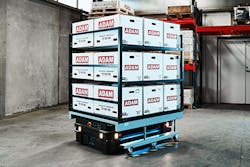Carsten Sørensen is partner at ROEQ. Sørensen has a master’s degree in mechanical engineering from Technical University of Denmark (DTU). After three years with Andersen Consulting, he worked as a consultant in mechanical engineering for product development. During this time, he worked together with Michael Ejstrup Hansen on product innovation, mainly in the medical industry. He joined as partner in ROEQ in 2018 and is responsible for support and sales.
Which technologies have allowed warehouses to increase throughput rates while expanding product ranges and still maintaining accurate order fulfillment?
Carsten Sørensen, partner, ROEQ: When employing mobile robotic equipment (MRE), it is crucial that the equipment has a quality level ensuring a robust and steady production. What might seem as a straightforward and simple function often turns out to be crucial for the success of the application, especially if attention is not paid to details. Experience and routine are often determining factors as to whether a solution will work or not. We often hear from integrators who have tried to walk the path of developing MRE on their own, regretting their time spent on solutions that don’t work. Well-designed, tested and proven off-the-shelf solutions ease the task of taking onboard the new autonomous mobile robot (AMR), even for experienced automation houses.
Also read: Warehouse automation with the human touch
Figure 2: Combined with well-designed MRE solutions, AMR technology opens up new opportunities for automation.
Because of the warehouse’s physical nature, how much of the facility’s hardware can be replaced with software in order to facilitate easier upgrades, expansions and reconfigurations?
Carsten Sørensen, partner, ROEQ: A seamless flow of goods in warehouses and factories requires a seamless flow of data along with the goods. Connecting the AMRs with stationary conveyor stations often utilizes Wi-Fi for communication. Yet this entails certain challenges as Wi-Fi is not really suited for reliable transfer of real-time data, especially in factories with noisy machinery interfering with the Wi-Fi signals. Transferring signals to and from the AMR utilizing robust and proven sensor technology can address this well-known issue (Figure 1). Not only are the signals transferred reliably, but it also happens fast, reducing the cycle time when transferring goods between robot and conveyor stations. Swift communication also solves timing issues ensuring that the rolls on the robot conveyor start and stop simultaneously with the rolls on the conveyor station, also during unintended interruptions of goods transfer.
Will autonomous mobile robots replace automated guided vehicles altogether, or is there room for both, based on the application or complementary functions?
Carsten Sørensen, partner, ROEQ: The AMR technology is so mature that it can take on the exact same tasks that AGVs used to solve. Combined with well-designed MRE solutions, the AMR technology opens up new opportunities for automation (Figure 2). Businesses that never considered AGVs due to high installation costs now look toward automation. Increased flexibility that comes with the AMR technology also points toward more areas that are suited for automation. AMRs quickly adapt to changes in production and factory layouts, and off-the-shelf MRE supports this flexibility.
As warehouse distribution centers continue to grow larger, how are tracking and intelligence helping to keep up with customer demands?
Carsten Sørensen, partner, ROEQ: Transparency—knowing at all times where all goods are in the facility it’s obviously crucial for an automated production and stream of goods. For that to succeed, a steady and reliable flow of data must be supported by all systems within the facility. Looking into the future this ability will be crucial when choosing the robotic equipment.
Mike Bacidore is the editor in chief for Control Design magazine. He is an award-winning columnist, earning a Gold Regional Award and a Silver National Award from the American Society of Business Publication Editors. Email him at [email protected].
About the Author
Mike Bacidore
Editor in Chief
Mike Bacidore is chief editor of Control Design and has been an integral part of the Endeavor Business Media editorial team since 2007. Previously, he was editorial director at Hughes Communications and a portfolio manager of the human resources and labor law areas at Wolters Kluwer. Bacidore holds a BA from the University of Illinois and an MBA from Lake Forest Graduate School of Management. He is an award-winning columnist, earning multiple regional and national awards from the American Society of Business Publication Editors. He may be reached at [email protected]

Leaders relevant to this article:




